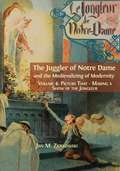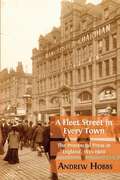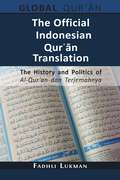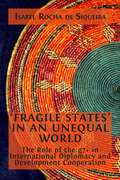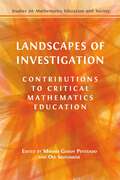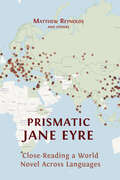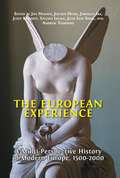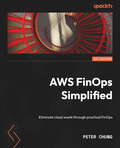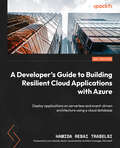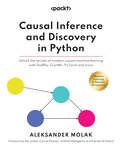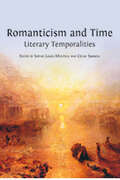- Table View
- List View
The Juggler of Notre Dame and the Medievalizing of Modernity. Volume 4: Vol. 4: Picture That: Making A Show Of The Jongleur
by Jan M. ZiolkowskiThis ambitious and vivid study in six volumes explores the journey of a single, electrifying story, from its first incarnation in a medieval French poem through its prolific rebirth in the nineteenth and twentieth centuries. The Juggler of Notre Dame tells how an entertainer abandons the world to join a monastery, but is suspected of blasphemy after dancing his devotion before a statue of the Madonna in the crypt; he is saved when the statue, delighted by his skill, miraculously comes to life. Jan Ziolkowski tracks the poem from its medieval roots to its rediscovery in late nineteenth-century Paris, before its translation into English in Britain and the United States. The visual influence of the tale on Gothic revivalism and vice versa in America is carefully documented with lavish and inventive illustrations, and Ziolkowski concludes with an examination of the explosion of interest in The Juggler of Notre Dame in the twentieth century and its place in mass culture today. Volume 4 examines the famous Le jongleur de Notre Dame by the French composer Jules Massenet, which took Europe by storm after premiering in 1902 and then crossed the Atlantic to the impresario Oscar Hammerstein and the diva Mary Garden, who gave the opera new legs as a female juggler. Presented with great clarity and simplicity, Ziolkowski's work is accessible to the general reader, while its many new discoveries will be valuable to academics in such fields and disciplines as medieval studies, medievalism, philology, literary history, art history, folklore, performance studies, and reception studies.
Life Histories of Etnos Theory in Russia and Beyond
by David G. Anderson Dmitry V. Arzyutov Sergei S. AlymovThe idea of etnos came into being over a hundred years ago as a way of understanding the collective identities of people with a common language and shared traditions. In the twentieth century, the concept came to be associated with Soviet state-building, and it fell sharply out of favour. Yet outside the academy, etnos-style arguments not only persist, but are a vibrant part of regional anthropological traditions. Life Histories of Etnos Theory in Russia and Beyond makes a powerful argument for reconsidering the importance of etnos in our understanding of ethnicity and national identity across Eurasia. The collection brings to life a rich archive of previously unpublished letters, fieldnotes, and photographic collections of the theory’s early proponents. Using contemporary fieldwork and case studies, the volume shows how the ideas of these ethnographers continue to impact and shape identities in various regional theatres from Ukraine to the Russian North to the Manchurian steppes of what is now China. Through writing a life history of these collectivist concepts, the contributors to this volume unveil a world where the assumptions of liberal individualism do not hold. In doing so, they demonstrate how notions of belonging are not fleeting but persistent, multi-generational, and bio-social.
A Fleet Street In Every Town: The Provincial Press In England, 1855-1900
by Andrew HobbsAt the heart of Victorian culture was the local weekly newspaper. More popular than books, more widely read than the London papers, the local press was a national phenomenon. This book redraws the Victorian cultural map, shifting our focus away from one centre, London, and towards the many centres of the provinces. It offers a new paradigm in which place, and a sense of place, are vital to the histories of the newspaper, reading and publishing. Hobbs offers new perspectives on the nineteenth century from an enormous yet neglected body of literature: the hundreds of local newspapers published and read across England. He reveals the people, processes and networks behind the publishing, maintaining a unique focus on readers and what they did with the local paper as individuals, families and communities. Case studies and an unusual mix of quantitative and qualitative evidence show that the vast majority of readers preferred the local paper, because it was about them and the places they loved. A Fleet Street in Every Town positions the local paper at the centre of debates on Victorian newspapers, periodicals, reading and publishing. It reorientates our view of the Victorian press away from metropolitan high culture and parliamentary politics, and towards the places where most people lived, loved and read. This is an essential book for anybody interested in nineteenth-century print culture, journalism and reading.
Hanging on to the Edges: Essays On Science, Society And The Academic Life
by Daniel NettleWhat does it mean to be a scientist working today; specifically, a scientist whose subject matter is human life? Scientists often overstate their claim to certainty, sorting the world into categorical distinctions that obstruct rather than clarify its complexities. In this book Daniel Nettle urges the reader to unpick such distinctions—biological versus social sciences, mind versus body, and nature versus nurture—and look instead for the for puzzles and anomalies, the points of connection and overlap. These essays, converted from often humorous, sometimes autobiographical blog posts, form an extended meditation on the possibilities and frustrations of the life scientific. Pragmatically arguing from the intersection between social and biological sciences, Nettle reappraises the virtues of policy initiatives such as Universal Basic Income and income redistribution, highlighting the traps researchers and politicians are liable to encounter. This provocative, intelligent and self-critical volume is a testament to the possibilities of interdisciplinary study—whose virtues Nettle stridently defends—drawing from and having implications for a wide cross-section of academic inquiry. This will appeal to anybody curious about the implications of social and biological sciences for increasingly topical political concerns. It comes particularly recommended to Sciences and Social Sciences students and to scholars seeking to extend the scope of their field in collaboration with other disciplines.
Virgil, Aeneid 11, Pallas and Camilla, 1–224, 498–521, 532–596, 648–689, 725–835: Latin Text, Study Aids With Vocabulary, And Commentary (Classics Textbooks Ser. #Vol. 7)
by Ingo Gildenhard John HendersonA dead boy (Pallas) and the death of a girl (Camilla) loom over the opening and the closing part of the eleventh book of the Aeneid. Following the savage slaughter in Aeneid 10, the book opens in a mournful mood as the warring parties revisit yesterday’s killing fields to attend to their dead. One casualty in particular commands attention: Aeneas’ protégé Pallas, killed and despoiled by Turnus in the previous book. His death plunges his father Evander and his surrogate father Aeneas into heart-rending despair – and helps set up the foundational act of sacrificial brutality that caps the poem, when Aeneas seeks to avenge Pallas by slaying Turnus in wrathful fury. Turnus’ departure from the living is prefigured by that of his ally Camilla, a maiden schooled in the martial arts, who sets the mold for warrior princesses such as Xena and Wonder Woman. In the final third of Aeneid 11, she wreaks havoc not just on the battlefield but on gender stereotypes and the conventions of the epic genre, before she too succumbs to a premature death. In the portions of the book selected for discussion here, Virgil offers some of his most emotive (and disturbing) meditations on the tragic nature of human existence – but also knows how to lighten the mood with a bit of drag. This course book offers the original Latin text, vocabulary aids, study questions, and an extensive commentary. Designed to stretch and stimulate readers, Ingo Gildenhard’s volume will be of particular interest to students of Latin studying for A-Level or on undergraduate courses. It extends beyond detailed linguistic analysis to encourage critical engagement with Virgil’s poetry and the most recent scholarly thought.
Studies in Rabbinic Hebrew
by Shai HeijmansThis volume presents a collection of articles centring on the language of the Mishnah and the Talmud – the most important Jewish texts (after the Bible), which were compiled in Palestine and Babylonia in the latter centuries of Late Antiquity. Despite the fact that Rabbinic Hebrew has been the subject of growing academic interest across the past century, very little scholarship has been written on it in English. Studies in Rabbinic Hebrew addresses this lacuna, with eight lucid but technically rigorous articles written in English by a range of experienced scholars, focusing on various aspects of Rabbinic Hebrew: its phonology, morphology, syntax, pragmatics and lexicon. This volume is essential reading for students and scholars of Rabbinic studies alike, and constitutes the first in a new series, Studies in Semitic Languages and Cultures, in collaboration with the Faculty of Asian and Middle Eastern Studies at the University of Cambridge.
Studies in Rabbinic Hebrew
by Shai HeijmansThis volume presents a collection of articles centring on the language of the Mishnah and the Talmud – the most important Jewish texts (after the Bible), which were compiled in Palestine and Babylonia in the latter centuries of Late Antiquity. Despite the fact that Rabbinic Hebrew has been the subject of growing academic interest across the past century, very little scholarship has been written on it in English. Studies in Rabbinic Hebrew addresses this lacuna, with eight lucid but technically rigorous articles written in English by a range of experienced scholars, focusing on various aspects of Rabbinic Hebrew: its phonology, morphology, syntax, pragmatics and lexicon. This volume is essential reading for students and scholars of Rabbinic studies alike, and constitutes the first in a new series, Studies in Semitic Languages and Cultures, in collaboration with the Faculty of Asian and Middle Eastern Studies at the University of Cambridge.
A Lexicon of Medieval Nordic Law
by Jeffrey Love, Inger Larsson, Ulrika Djärv, Christine Peel, and Erik SimensenA Lexicon of Medieval Nordic Law is an indispensable resource for scholars and students of medieval Scandinavia. This polyglot dictionary draws on the vast and vibrant range of vernacular legal terminology found in medieval Scandinavian texts – terminology which yields valuable insights into the quotidian realities of crime and retribution; the processes, application and execution of laws; and the cultural and societal concerns underlying the development and promulgation of such laws.
The Official Indonesian Qur'ān Translation: The History and Politics of Al-Qur’an dan Terjemahnya
by Fadhli LukmanThis book studies the political and institutional project of Al-Qur’an dan Terjemahnya, the official translation of the Qurʾān into Indonesian by the Indonesian government. It investigates how the translation was produced and presented, and how it is read, as well as considering the implications of the state’s involvement in such a work.
‘Fragile States’ in an Unequal World
by Isabel Rocha de SiqueiraThis is a book about people. ‘Fragile States’ in an Unequal World: The Role of the g7+ in International Diplomacy and Development Cooperation introduces the members of the g7+, a group formed by 20 conflict-affected states: why they came to believe in politics and policy; how they feel about their work, their family and their communities; and what they want to leave behind for the next generations It is the story of their personal and collective values, their mistakes, and the challenges they faced, and it will resonate with anyone who has tried to organize and work with a group of very different people.
‘Fragile States’ in an Unequal World
by Isabel Rocha de SiqueiraThis is a book about people. ‘Fragile States’ in an Unequal World: The Role of the g7+ in International Diplomacy and Development Cooperation introduces the members of the g7+, a group formed by 20 conflict-affected states: why they came to believe in politics and policy; how they feel about their work, their family and their communities; and what they want to leave behind for the next generations It is the story of their personal and collective values, their mistakes, and the challenges they faced, and it will resonate with anyone who has tried to organize and work with a group of very different people.
Landscapes of Investigation: Contributions to Critical Mathematics Education
by Miriam Godoy Penteado and Ole SkovsmoseCreating landscapes of investigation is a primary concern of critical mathematics education. It enables us to organise educational processes so that students and teachers are able to get involved in explorations guided by dialogical interactions. It attempts to address explicit or implicit forms of social injustice by means of mathematics, and also to promote a critical conception of mathematics, challenging the assumption that the subject represents objectivity and neutrality. Landscapes of Investigation provides many illustrations of how this can be done in primary, secondary, and university education. It also illustrates how exploring landscapes of investigation can contribute to mathematics teacher education programmes.
Landscapes of Investigation: Contributions to Critical Mathematics Education
by Miriam Godoy Penteado and Ole SkovsmoseCreating landscapes of investigation is a primary concern of critical mathematics education. It enables us to organise educational processes so that students and teachers are able to get involved in explorations guided by dialogical interactions. It attempts to address explicit or implicit forms of social injustice by means of mathematics, and also to promote a critical conception of mathematics, challenging the assumption that the subject represents objectivity and neutrality. Landscapes of Investigation provides many illustrations of how this can be done in primary, secondary, and university education. It also illustrates how exploring landscapes of investigation can contribute to mathematics teacher education programmes.
Prismatic Jane Eyre: Close-Reading a World Novel Across Languages
by Matthew Reynolds OthersJane Eyre, written by Charlotte Brontë and first published in 1847, has been translated more than five hundred times into over sixty languages. Prismatic Jane Eyre argues that we should see these many re-writings, not as simple replications of the novel, but as a release of its multiple interpretative possibilities: in other words, as a prism. Prismatic Jane Eyre develops the theoretical ramifications of this idea, and reads Brontë’s novel in the light of them: together, the English text and the many translations form one vast entity, a multilingual world-work, spanning many times and places, from Cuba in 1850 to 21st-century China; from Calcutta to Bologna, Argentina to Iran. Co-written by many scholars, Prismatic Jane Eyre traces the receptions of the novel across cultures, showing why, when and where it has been translated (and no less significantly, not translated – as in Swahili), and exploring its global publishing history with digital maps and carousels of cover images. Above all, the co-authors read the translations and the English text closely, and together, showing in detail how the novel’s feminist power, its political complexities and its romantic appeal play out differently in different contexts and in the varied styles and idioms of individual translators. Tracking key words such as ‘passion’ and ‘plain’ across many languages via interactive visualisations and comparative analysis, Prismatic Jane Eyre opens a wholly new perspective on Brontë’s novel, and provides a model for the collaborative close-reading of world literature. Prismatic Jane Eyre is a major intervention in translation and reception studies and world and comparative literature. It will also interest scholars of English literature, and readers of the Brontës.
Prismatic Jane Eyre: Close-Reading a World Novel Across Languages
by Matthew Reynolds OthersJane Eyre, written by Charlotte Brontë and first published in 1847, has been translated more than five hundred times into over sixty languages. Prismatic Jane Eyre argues that we should see these many re-writings, not as simple replications of the novel, but as a release of its multiple interpretative possibilities: in other words, as a prism. Prismatic Jane Eyre develops the theoretical ramifications of this idea, and reads Brontë’s novel in the light of them: together, the English text and the many translations form one vast entity, a multilingual world-work, spanning many times and places, from Cuba in 1850 to 21st-century China; from Calcutta to Bologna, Argentina to Iran. Co-written by many scholars, Prismatic Jane Eyre traces the receptions of the novel across cultures, showing why, when and where it has been translated (and no less significantly, not translated – as in Swahili), and exploring its global publishing history with digital maps and carousels of cover images. Above all, the co-authors read the translations and the English text closely, and together, showing in detail how the novel’s feminist power, its political complexities and its romantic appeal play out differently in different contexts and in the varied styles and idioms of individual translators. Tracking key words such as ‘passion’ and ‘plain’ across many languages via interactive visualisations and comparative analysis, Prismatic Jane Eyre opens a wholly new perspective on Brontë’s novel, and provides a model for the collaborative close-reading of world literature. Prismatic Jane Eyre is a major intervention in translation and reception studies and world and comparative literature. It will also interest scholars of English literature, and readers of the Brontës.
The European Experience
by Jan Hansen;Jochen Hung;Jaroslav Ira;Judit Klement;Sylvain Lesage;Juan Luis Simal;Andrew TompkinsThe European Experience brings together the expertise of nearly a hundred historians from eight European universities to internationalise and diversify the study of modern European history, exploring a grand sweep of time from 1500 to 2000.
The European Experience
by Jan Hansen;Jochen Hung;Jaroslav Ira;Judit Klement;Sylvain Lesage;Juan Luis Simal;Andrew TompkinsThe European Experience brings together the expertise of nearly a hundred historians from eight European universities to internationalise and diversify the study of modern European history, exploring a grand sweep of time from 1500 to 2000.
Genetic Inroads into the Art of James Joyce
by Hans Walter GablerThis book is a treasure trove comprising core writings from Hans Walter Gabler‘s seminal work on James Joyce, spanning fifty years from the analysis of composition he undertook towards a critical text of A Portrait of the Artist as a Young Man, through the Critical and Synoptic Edition of Ulysses, to Gabler‘s latest essays on (appropriately enough) Joyce’s sustained artistic innovation. Not only does this span of essays trace the evolution of Gabler’s thinking about Joyce’s originality and creative energy. It also reflects the development and maturation of Gabler‘s own genetic criticism and his methodology of genetic editing, which grows in depth and complexity across the collection. The reader will explore Joyce’s life and works through Gabler’s incisive eye, while also examining a progress of his reflections on his edition of Ulysses and the past controversy that beset it. This classic compendium combining well-seasoned scholarship and fresh criticism is an essential read for critics of Modernism, digital humanists, scholars and students of James Joyce, and anyone interested in the art of literary analysis.
A Relational Realist Vision for Education Policy and Practice
by Basem AdiThis volume argues that relational realism can help us to make better educational policy that is more effective in practice. Basem Adi draws on critical realism to thoroughly re-examine fundamental assumptions about how government policymaking works, developing an ontological basis from which to examine existing government approaches and imagine an alternative approach based on a relational realist-informed critical pedagogy.
A Relational Realist Vision for Education Policy and Practice
by Basem AdiThis volume argues that relational realism can help us to make better educational policy that is more effective in practice. Basem Adi draws on critical realism to thoroughly re-examine fundamental assumptions about how government policymaking works, developing an ontological basis from which to examine existing government approaches and imagine an alternative approach based on a relational realist-informed critical pedagogy.
Translating Russian Literature in the Global Context
by Muireann Maguire Cathy McAteerTranslating Russian Literature in the Global Context examines the translation and reception of Russian literature as a world-wide process. This volume aims to provoke new debate about the continued currency of Russian literature as symbolic capital for international readers, in particular for nations seeking to create or consolidate cultural and political leverage in the so-called ‘World Republic of Letters’. It also seeks to examine and contrast the mechanisms of the translation and uses of Russian literature across the globe. This collection presents academic essays, grouped according to geographical location, by thirty-seven international scholars. Collectively, their expertise encompasses the global reception of Russian literature in Europe, the Former Soviet Republics, Africa, the Americas, and Asia. Their scholarship concentrates on two fundamental research areas: firstly, constructing a historical survey of the translation, publication, distribution and reception of Russian literature, or of one or more specific Russophone authors, in a given nation, language, or region; and secondly, outlining a socio-cultural microhistory of how a specific, highly influential local writer, genre, or literary group within the target culture has translated, transmitted, or adapted aspects of Russian literature in their own literary production. Each section is prefaced with a short essay by the co-editors, surveying the history of the reception of Russian literature in the given region. Considered as a whole, these chapters offer a wholly new overview of the extent and intercultural penetration of Russian and Soviet literary soft power during the twentieth and twenty-first centuries. This volume will open up Slavonic Translation Studies for the general reader, the student of Comparative Literature, and the academic scholar alike.
AWS FinOps Simplified: Eliminate Cloud Waste Through Practical Finops
by Peter ChungEliminate cloud waste through practical FinOps
A Developer's Guide to Building Resilient Cloud Applications with Azure: Deploy Applications On Serverless And Event-driven Architecture Using A Cloud Database
by Hamida Rebai TrabelsiDeploy applications on serverless and event-driven architecture using a cloud database
Implementing Multifactor Authentication: Unlock The Secrets Of Modern Causal Machine Learning With Dowhy, Econml, Pytorch And More
by Marco FantiProtect your applications from cyberattacks with the help of MFA
Destins de femmes: French Women Writers, 1750-1850
by John Claiborne IsbellDestins de femmes is the first comprehensive overview of French women writers during the turbulent period of 1750-1850. John Isbell provides an essential collection that illuminates the impact women writers had on French literature and politics during a time marked by three revolutions, the influx of Romantic art, and rapid technological change.
